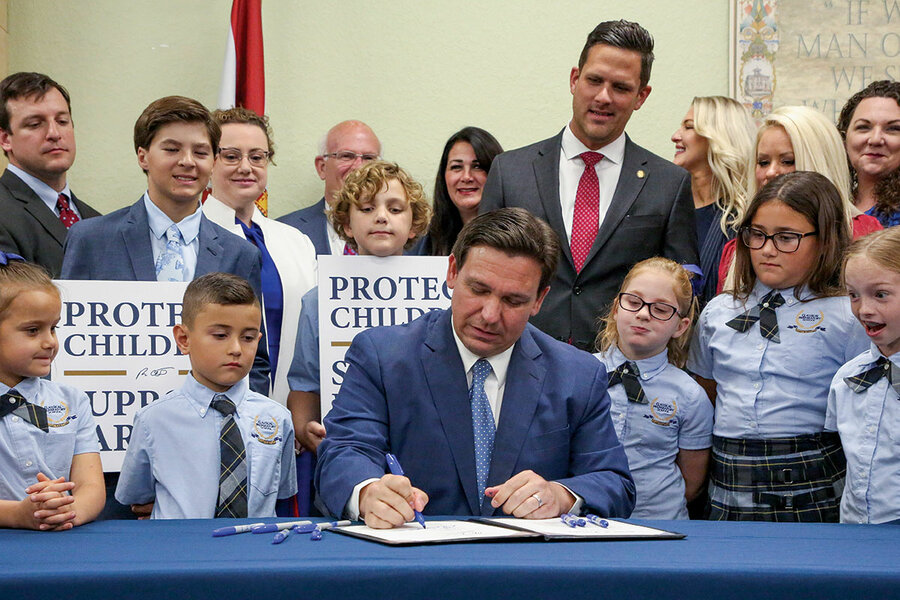How much say does a governor have over the classroom?
Loading...
With legislative sessions in full swing across the nation, state lawmakers are considering a raft of bills that could change how and what students are taught.
The areas addressed by the proposed legislation include student mental health, teacher staffing, and the role of career and technical education. Other bills put issues such as gender studies, the teaching of history, and parent rights under the microscope. Proposed laws also address what can or cannot exist in school classrooms and libraries related to books.
Why We Wrote This
A story focused onAs the culture wars drift further into the education realm, they’re spawning questions fundamentally tied to American democracy.
Florida Gov. Ron DeSantis, a Republican, has led the charge in making education reforms a signature aspect of his political agenda. He garnered much attention last year after signing into law legislation addressing culture war issues such as how and when race, sexuality, and gender are taught in public schools.
So far this year, legislation has been introduced in at least 19 states that would curtail teaching related to “divisive concepts or critical race theory” in public schools or higher education institutions, according to tracking done by the National Conference of State Legislatures.
As these policy debates play out in legislatures, two concepts are simmering under the surface: gubernatorial authority and free speech.
With legislative sessions in full swing across the nation, state lawmakers are considering a raft of bills that could change how and what students are taught.
Some of the proposed legislation addresses student mental health, teacher staffing, and the role of career and technical education. Other bills put issues such as gender studies, the teaching of history, and parent rights under the microscope. Proposed laws concerning what can or cannot exist in school classrooms and libraries related to books have also emerged as another entry point for those seeking educational reform.
In many respects, Florida Gov. Ron DeSantis, a Republican, has led the charge in making education reforms a signature aspect of his political agenda. He garnered much attention last year after signing into law the “Stop WOKE Act,” addressing culture war issues such as how and when race, sexuality, and gender are taught in public schools. But he’s hardly the only governor or state lawmaker proposing or supporting such changes.
Why We Wrote This
A story focused onAs the culture wars drift further into the education realm, they’re spawning questions fundamentally tied to American democracy.
So far this year, legislation has been introduced in at least 19 states that would curtail teaching related to “divisive concepts or critical race theory” in public schools or higher education institutions, according to tracking done by the National Conference of State Legislatures. More than a dozen other states have already passed similar legislation or made policy changes via administrative or board action.
As these policy debates play out in legislatures, two concepts simmering under the surface are gubernatorial authority and free speech.
How much can governors control what’s taught inside kindergarten through 12th-grade classrooms?
The answer to this question rests in states’ rights and separation of powers. The U.S. Constitution does not include a single mention of education. Per the Tenth Amendment, education is one of the powers reserved for the states.
“Education is mentioned in every state constitution,” says Kenneth Wong, professor of education policy at Brown University. “So that’s really an important institutional context to what we are seeing today.”
Gubernatorial power, however, differs by state constitution, Mr. Wong says. Some states constrain the governor’s authority by making the legislative branch more powerful, and in other states, governors have stronger executive authority.
Even so, governors can set the tone and direction. Their proposed budgets must be approved by state lawmakers, meaning changes can occur within the legislative process, Mr. Wong says.
Additionally, many governors have authority to appoint people to state executive branch positions, though those nominations may need to be confirmed by one or both houses of the legislature. Depending on the state, governors may also nominate people to serve on state boards and commissions, which can influence education.
Mr. Wong says more than half of states allow the governor to appoint the state superintendent of public education.
Are there more restrictions on free speech inside of schools?
The First Amendment, largely considered the foundation of American democracy, only contains 45 words, yet provides that Congress shall not limit freedom of speech, press, petition, assembly, or religion.
It’s one of the simpler amendments, says Ken Paulson, director of the Free Speech Center at Middle Tennessee State University.
“Where it gets trickier is when we begin to look at the rights of various parties under various circumstances,” Mr. Paulson says.
Children receive their First Amendment rights at birth in the United States, though they’re not always as broad or powerful because they grow into them, Mr. Paulson says. Looking at schools, specifically, it first depends on the type of education setting.
“The First Amendment only applies if the government is involved in some way in restricting free expression,” he says. “So you take that off the table: Private schools can make their own rules to do whatever they want.”
Throughout history, when conflicts have surfaced over what children should be learning in public schools, the courts typically have deferred to local school boards and government officials – operating under the theory that those closest to the students know what’s best, Mr. Paulson says. However, he says so-called culture wars over material outside the scope of reading, writing, and math have introduced political agendas into the equation.
Mr. Paulson points to removing books from schools’ centralized libraries or teachers’ classroom libraries as a question that falls under the umbrella of free speech rights. Schools boards have “tremendous control” over curriculum, he says, but libraries are a different matter because the books housed within them are not required materials.
“The school board’s control over that is less – is somewhat less – because it’s not part of the daily curriculum of the school,” he says.
A 1982 U.S. Supreme Court case (Board of Education, Island Trees Union Free School District v. Pico) centered around a school board’s decision to remove books from a school library. In a 5-4 vote, the nation’s highest court ruled that a trial should have been held rather than awarding summary judgment to the school board.
Justice William Brennan Jr., who authored the principal opinion, wrote that though school boards have broad discretion over school affairs, it “must be exercised in a manner that comports with the transcendent imperatives of the First Amendment.”
Do higher education institutions have greater freedom when it comes to curriculum than K-12 schools?
Yes, and that’s largely because of “academic freedom,” a concept often baked into a college or university’s mission or policy statement.
Legislation signed into law last year by Governor DeSantis has put that concept into the national spotlight. The Stop WOKE (Wrongs to Our Kids and Employees) Act, which restricts how race is discussed in schools, colleges, and workplaces, has run into a series of legal challenges. Most recently, a federal appeals court last week ruled that it cannot be enforced at public colleges and universities as the case continues to be adjudicated.
The American Association of University Professors defines academic freedom as “the freedom of a teacher or researcher in higher education to investigate and discuss the issues in his or her academic field, and to teach or publish findings without interference from political figures, boards of trustees, donors, or other entities.”
The organization goes on to say academic freedom protects the rights of faculty members “to speak freely when participating in institutional governance, as well as to speak freely as a citizen.”
Mr. Wong says academic freedom is built upon the foundation of progress.
“We don’t want to restrict the way we think and the way we think about research projects – and the way that we train our students – because that would compromise us from pushing forward with the best idea,” he says. “And the history of scientific discovery is exactly that.”
Though academic freedom gives professors a “buffer of protection,” Mr. Paulson says it’s not absolute. Academic freedom may not exist if professors do or say something that makes them incapable of performing the job they were hired to do, he says. For instance, Mr. Paulson says, if a science professor declares evolution a hoax, that makes them “ineffective as a professor” even if it’s their opinion as a citizen.








